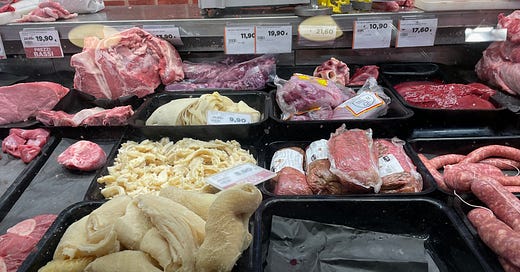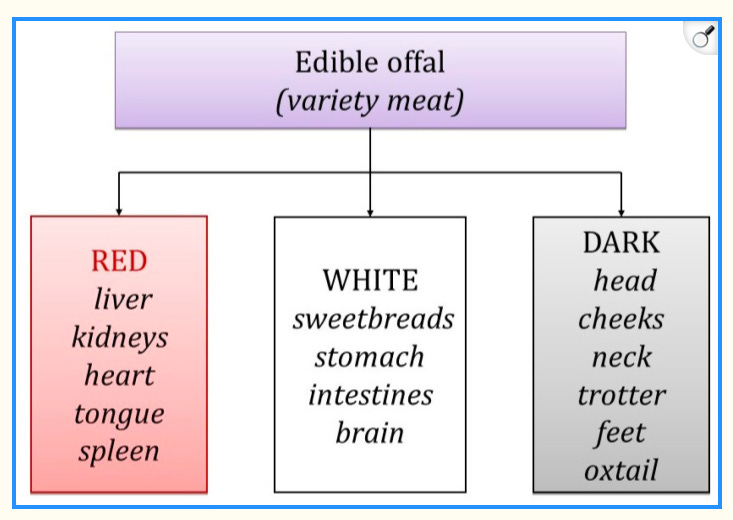I recently returned from a trip to Italy, where I made my regular pilgrimage to favourite restaurants and food markets.
One evening in a town centre restaurant I noticed that a little boy, around ten years old and sitting at the next table with his family, had a plate of tripe for his main course. He ate the whole lot without grudge or persuasion. He then proceeded to mop his plate with a piece of bread.
Tripe on an Italian menu is nothing out of the ordinary, and neither is tripe in the food market, alongside heart, tongue, tail, trotters and cheeks.
Indeed, that same morning I visited the local food market and admired all the bits of offal on display.
Certain aspects of nose-to-tail eating are enjoying a fashionable revival. A niche revival, but still. What may once have been discarded with a degree of revulsion - marrow and connective tissue, for example - has resurfaced as bone broth and collagen.
In some countries, these edible innards never fell out of fashion. They form part of the real Mediterranean diet, not that fabricated nonsense that nobody eats, based on ‘wholegrains’ and barely any meat. In Italy, offal is central to ‘cucina povera’, the food of the poor. It’s the food that historically sustained rural communities and the working classes who put their creative resourcefulness to good use and transformed cheap cuts into fine dining.
What is offal? The EU classification of edible offal
Image: Nutrients. 2024 May 24;16(11):1609. doi: 10.3390/nu16111609
Of course, all this was once the norm. The further back you go, the more normal it was. Our hunter-gatherer ancestors would have devoured the whole animal, and then wore the skin and fur.
Whenever I research the richest source of any given nutrient, liver, especially beef liver, and other offal meats almost always top the chart.
Beyond organ meat there are other parts of an animal that offer similar nutrient density. Here are a few of them, starting with tripe.
Tripe
Tripe is the intestines and stomach from a ruminant, usually beef or sheep. There are two types: plain, from the first stomach, or rumen, and honeycomb, produced from the second.
Tripe doesn’t taste of much, but it absorbs other flavours beautifully, rather like bland vegetables. Stews, soups and casseroles are all great carriers for this nutrient-dense food. Like any offal that is exceptionally high in connective tissue, it is quite tough unless cooked for a long time.
The star qualities of tripe include:
Pigs’ trotters
Also known as pettitoes, you wouldn’t think these would taste of much, but they have a rich, gelatinous consistency. Like tripe, they need to be cooked well and for long to break down all that connective tissue.
They are especially rich in:
Oxtail
Growing up, tinned oxtail soup was a comfort food staple. Amazingly, it is still available from supermarkets. Most oxtail comes from beef cattle and consists of bone, marrow, and gelatinous meat. It has a lovely rich, meaty flavour.
Beef oxtail is especially rich in:
Beef tongue
Beef tongue is exceptionally fatty, for which you can read flavoursome.
It is especially rich in:
Honourable mentions should also go to other stand-out features of these foods. These include fatty acids.
The fatty acid profile of offal is impressive, featuring saturated, monounsaturated and polyunsaturated fats. The proportion of each time varies widely but is generally similar to or lower than muscle meat.
Offal is richer than muscle meat in certain biologically active substances, including coenzyme Q10 and glutathione, the body’s ‘master’ antioxidant. It also has more choline. Choline forms part of the neurotransmitter acetylcholine, required for memory retrieval in the elderly and the formation of neurons in the child’s developing brain.
‘The array of biologically active compounds present in offal offers multiple health benefits, such as antioxidant, anticancer, antihypertensive, anti-inflammatory, anticoagulant, cytomodulatory, and immunomodulatory effects, as well as boosting metabolism, enhancing digestion, and contributing to the reduction in blood glucose levels’
It’s a tragedy that offal has been relegated to ‘by-product’ status in developed countries. These discarded cuts comprise up to 40% of an animal’s carcass weight. Despite being more nutritious than muscle meat, it ends up as pet food.
My dog has no complaints though, and loves his regular treats of dried trachea, pigs’ ears, and chicken feet.
He is almost certainly better nourished than most children in the UK and elsewhere, where comcomitant obesity and malnutrition is now the norm. The result is that children are getting shorter, and fatter. Ironically, the nutrients that the children lack most are those found mainly in muscle meat and offal: iron, vitamins A and B12, and zinc.
‘The optimal use of offal in processing and catering can significantly benefit aspects of human life, including diet quality, food security, and conservation of natural resources.’
Rather than wasting time and resources on meat alternatives, or forcing ourselves to eat insects, it would make a lot more sense to return to a more economical and less wasteful way of eating.
Food neophobia and cultural conditioning have led us to drift away from our food heritage, but we can still drift back to our cultural roots. Some countries, like Italy, never left them.











I grew up in the countryside in Southwest of France. Offals were the norm. As a kid I loved tripes with homemade vinegar. We were raising chickens and always cooked the full chicken with head and neck. My favorite parts were: the gizzard, heart, crest, neck (with the spine), and my dad was cutting the head in half so I could eat the brain 😄. Sounds horrific but it is delicious. We also used to make soup with chicken feet. A month ago I made one. The best collagen boost!
My mom, who grew up on a farm in Germany, also cooked a very good tripe in a tomato sauce. Someday I’ll try and recreate it. My local taco place has tripe tacos. However, the al pastor option is so good I haven’t tried them yet.